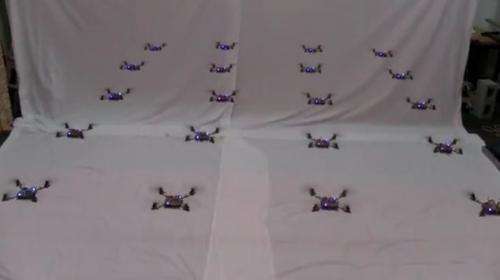February 2, 2012 report
Airborne robot swarms are making complex moves (w/ video)

(PhysOrg.com) -- The GRASP Lab at the University of Pennsylvania this week released a video that shows their new look in GRASP Lab robotic flying devices. They are now showing flying devices with more complex behavior than before, in a fleet of flying devices that move in packs, navigate spaces with obstacles, flip over and retain position, and carry out formation flying,
The researchers have cut down these robotic creature-like drones to small size to what they call “nano-quadrotors.” The video shows them in action: not just engaged in formation flying, but also creating an impressive looking figure-eight pattern.
The video says as much about the GRASP Lab as the flying machines, in that the GRASP Labs seems intent on raising the bar on what robot swarms can achieve. Unfortunately, the video released is scant on technical detail.
Still, the video is clear proof that the team developers, Alex Kushleyev, Daniel Mellinger, and Vijay Kumar, are able to showcase complex autonomous swarm behavior.
The objects, in the words of Engadget, are “four-bladed aerial ninjas.” The announcer notes that the team has created “nano quadrotors capable of agile flight.”
The key word is agile. Robotics enthusiasts blogging on their reactions to the video this week said they were impressed with the precision performance in formation flying, and, overall, in the swarm behavior of the nano quadrotors--aware of each other and of each individual’s place in space. Each “nano” device is self-sensing; each can position itself, keep its balance, and behave as a group member in carrying out maneuvers.
GRASP stands for General Robotics, Automation, Sensing and Perception Laboratory. Its work integrates computer science, electrical engineering and mechanical engineering and involves students, research staff and faculty. GRASP’s nano-quadrotors are from the Lab’s “scalable sWarms of Autonomous Robots and Mobile Sensors” project. The project is working on new grouping skills in airborne robots. The researchers are trying to replicate swarming habits in nature. According to Vijay Kumar, a University of Pennsylvania professor and part of the team, explorations involve studying applications of biologically-inspired models of swarm behaviors to large networked groups of autonomously functioning vehicles.
Scenarios that use the flying devices are imagined in military and natural disaster settings.
“Can large numbers of autonomously functioning vehicles be reliably deployed in the form of a ‘swarm’ to carry out a prescribed mission and to respond as a group to high-level management commands? Can such a group successfully function in a potentially hostile environment, without a designated leader, with limited communications between its members, and/or with different and potentially dynamically changing “roles” for its members?”
These are the questions posed by the Lab. According to the SWARM project site, “Military missions will rely on large, networked groups of small vehicles and sensors operating in dynamic, resource-constrained, adversarial environments. Groups of this type will typically operate with little or no direct human supervision and will be very difficult, if not impossible, to efficiently manage or control by programming or by tele-operation. Management of such large groups will thus be extremely challenging and will require the application of new, yet-to-be-developed methods of communication, control, computation and sensing, specifically tailored to the command and control of large-scale, autonomously functioning vehicle groups.”
More information: www.swarms.org/
© 2011 PhysOrg.com




















